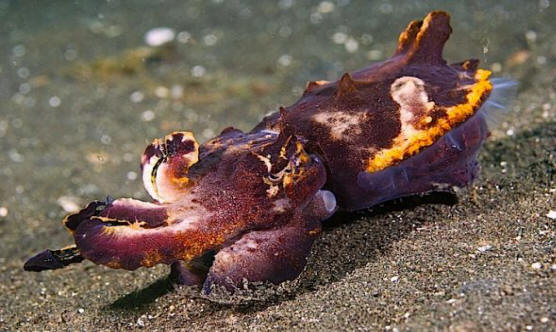.jpg)
Adaptation!
The Flamboyant Cuttlefish is a very unique species! Like other cephalopods, pfefferi can change the color of its skin to camouflage itself in the surrounding environment. This is what makes the cuttlefish and other mollusks such a unique species. It can also change its shape to look like another object such as a sea plant or coral. It does this by flexing and controlling its muscles independently. Cuttlefish and other mollusks have a special kind of pigment called a chromatophores which are connected to muscles and nerve endings of the mollusk that move depending on the surroundings. This is shown Here. We call these adaptations aposematic coloration which is changing into bright colors to show that the creature is venomus. They move unlike any other cehpolapod discovered by walking on the ocean bottom. Yes!! I said walking! like a Giraffe! This is a very interesting adaptation because scientist believe this may be an important evolutionary step.
 Another
great adaptation for the Metasepia pfefferi is the
poisonous toxin inside of the tissues. This cuttlefish does not use this
venom for anything more than defence because it is located in
the inner tissues of the organism. Researchers have found that
the poison is related to the toxicity of the Blue Ringed
Octopus. This adaptation has helped Metasepia pfefferi
survive in the wild due to the small size of this species.
Another
great adaptation for the Metasepia pfefferi is the
poisonous toxin inside of the tissues. This cuttlefish does not use this
venom for anything more than defence because it is located in
the inner tissues of the organism. Researchers have found that
the poison is related to the toxicity of the Blue Ringed
Octopus. This adaptation has helped Metasepia pfefferi
survive in the wild due to the small size of this species.
The Flamboyant Cuttlefish, like other cephalopods have very advanced eyes and aid in the detection of prey and predators from afar! Here is a website for their amazing eyes!
Check out the what the Flamboyant Cuttlefish hunts here